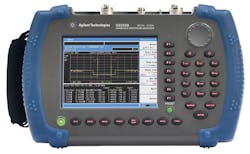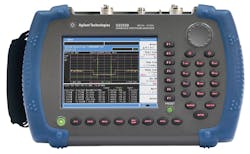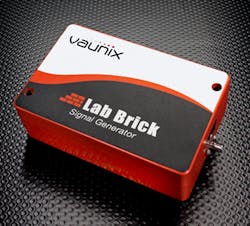Portable RF/microwave testing at remote locations once implied a battery-powered voltmeter. But handheld, portable RF/microwave test equipment has come a long way in the last decade, with the majority of benchtop measurement functions (such as signal generation and analysis) now available from portable packages. These miniature measurement powerhouses can be used manually, and many also include advanced test software programs and the latest computer interfaces for programmable and automatic testing at a remote site.
Related Articles
• Modules Take The Place Of Full-Sized Instruments
• Amplifier Systems Gain In Power
• Replace Components With A Single Module
When specifying a portable RF/microwave measurement instrument, many of the test requirements may remain the same from what might have been sought from a benchtop instrument, such as certain output power level and output-power flatness over a required frequency range for a signal generator. Whereas a benchtop and a portable signal generator may be specified for a particular output-power flatness level, such as ±1 dB across a given frequency range, the benchtop instrument is typically operating in the controlled (temperature) environment of a laboratory or production facility. The portable signal generator, on the other hand, may need to provide its specified output-power flatness versus a wider range of operating temperatures than the benchtop unit, requiring a closer look at those performance specifications that might be affected by its operating environments.
What constitutes a truly portable RF/microwave test instrument? A large number of compact instrumentation modules have been introduced in recent years, such as modules for PXI and PXI-Express (PXIe) systems. Modular instruments are particularly useful for applications, such as in production and manufacturing, where a large number of test functions are needed from a small equipment housing. By sliding a number of different-function modular PXI/PXIe instrument functions into a rack-mount mainframe, what is essentially a full measurement system can be created within the space formerly held by a single function, such as a signal generator. But modular instruments are not necessarily portable, although they provide a great deal of measurement functionality from a small volume.
Some modular test instruments may lend portability by merit of a Universal-Serial-Bus (USB) interface that allows these instruments to be controlled by a portable laptop computer with the appropriate software. When considering such instruments for portable test applications, however, it is recommended that the instruments are also powered by means of the USB bus; this will simplify setup and measurements made in a remote site, especially when relying on a portable computer’s power supply.
Because of the importance of signal analysis, one of the more popular of portable RF/microwave instruments is the spectrum analyzer. One of the earliest of portable RF/microwave spectrum analyzers is the model 492 from Tektronix. Not only did the 492 became legendary for its mobility and outstanding measurement capability, but its popularity played a key role in building the success of the company over the span of several decades. These portable spectrum analyzers were so well designed and constructed that units in excellent working condition can still be found on used-test-equipment websites.
Portable instruments such as the 492 spectrum analyzer established expectations for portable RF/microwave test instruments in terms of key parameters, such as measurement accuracy, frequency range, amplitude range, reliability, and even operating time on a battery charge. While newer portable spectrum analyzers may be considerably smaller and lighter than the robust 492, many can build upon the standards set by it for performance in a portable instrument.
Don't Forget Longevity
Portability in modern RF/microwave test instruments calls for small size and light weight, but also long operating times on a battery charge. As an example, model N9340B is a handheld RF spectrum analyzer from Agilent Technologies with a frequency range of 100 kHz to 3 GHz (Fig. 1). It shows measurements on a 6.5-in. thin-film-transistor (TFT) color liquid-crystal-display (LCD) screen. It can also operate for as long as four hours on a battery charge. For ease of use in the field, it features a number of one-button measurements, including channel power, adjacent-channel power ratio (ACPR), and occupied bandwidth (OBW). The compact spectrum analyzer includes Ethernet local-area-network (LAN) and USB ports for connection to a personal computer (PC). For even higher-frequency measurements, the firm’s model N9918A FieldFox analyzer combines spectrum analyzer, cable-and-antenna-test (CAT) analyzer, vector voltmeter, and power meter with measurement capability through 26.5 GHz—all in a handheld package capable of running for 3.5 hours on a single battery charge.Some USB instruments, such as the LSG series of Lab Brick signal generators from Vaunix Technology, can also operate under battery power or a remote power supply for truly portable applications (Fig. 2). Available in models from 20 MHz to 6 GHz, these compact test signal sources measure only 4.90 x 3.14 x 1.59 in. (124 x 80 x 40 mm) and weigh less than 1 lb. (0.45 kg). Although requirements for portable instruments used in military environments versus commercial settings may differ, most portable RF/microwave test instruments should be designed to provide full performance levels under harsh working conditions. Some military specifications, such as MIL-PRF-28800F Class-2 requirements, provide limits to define worst-case environments for portable electronic equipment. Parameters for this include temperature and humidity, altitude, vibration, shock, and even water moisture, with the specification that gasket seals can protect an instrument from moisture damage. In addition, requirements as outlined in the MIL-STD-810G standards even set recommendations for portable test equipment when operating in environments subject to sparks and explosions.
When considering test equipment for portable applications, many additional parameters may factor in. For a portable frequency synthesizer or signal generator, for example, a useful feature is the inclusion of an internal frequency reference source—such as an oven-controlled crystal oscillator (OCXO)—in contrast to reliance upon an external reference source. A portable signal generator should also provide similar amplitude flatness with frequency and frequency accuracy and stability when operating under battery power as when running on a USB connection or from an AC power adapter. Considerations for portable analyzers include many of the features of the portable signal generators, along with suitable display capability with an on-board screen, as well as an interface to connect to an external display screen (if needed).
Related Articles
• Modules Take The Place Of Full-Sized Instruments
• Amplifier Systems Gain In Power
• Replace Components With A Single Module
A current trend in portable RF/microwave measurement equipment is increased integration, so as to provide more functions from a single portable package, such as spectrum analyzers with built-in power meters or even test signal sources. As the military standards for portable equipment detail, highly integrated portable measurement solutions can be extremely useful for applications in which the test instruments must be carried to the test site, or even held in place while the measurements are being made. Under such conditions, the additional connection to a USB port on a PC is not feasible. Nonetheless, having the greatest number of measurement functions included within a single portable, light-weight package can make measurements at a remote site both possible and practical.
About the Author
Jack Browne
Technical Contributor
Jack Browne, Technical Contributor, has worked in technical publishing for over 30 years. He managed the content and production of three technical journals while at the American Institute of Physics, including Medical Physics and the Journal of Vacuum Science & Technology. He has been a Publisher and Editor for Penton Media, started the firm’s Wireless Symposium & Exhibition trade show in 1993, and currently serves as Technical Contributor for that company's Microwaves & RF magazine. Browne, who holds a BS in Mathematics from City College of New York and BA degrees in English and Philosophy from Fordham University, is a member of the IEEE.


